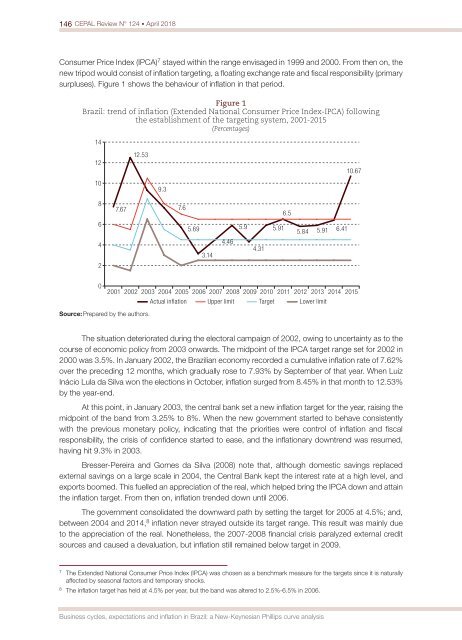CEPAL Review no. 124
April 2018
April 2018
Create successful ePaper yourself
Turn your PDF publications into a flip-book with our unique Google optimized e-Paper software.
146 <strong>CEPAL</strong> <strong>Review</strong> N° <strong>124</strong> • April 2018<br />
Consumer Price Index (IPCA) 7 stayed within the range envisaged in 1999 and 2000. From then on, the<br />
new tripod would consist of inflation targeting, a floating exchange rate and fiscal responsibility (primary<br />
surpluses). Figure 1 shows the behaviour of inflation in that period.<br />
Figure 1<br />
Brazil: trend of inflation (Extended National Consumer Price Index-IPCA) following<br />
the establishment of the targeting system, 2001-2015<br />
(Percentages)<br />
14<br />
12<br />
12.53<br />
10.67<br />
10<br />
9.3<br />
8<br />
7.67<br />
7.6<br />
6.5<br />
6<br />
4<br />
2<br />
5.69<br />
3.14<br />
4.46<br />
5.9<br />
4.31<br />
5.91<br />
5.84 5.91 6.41<br />
0<br />
Source: Prepared by the authors.<br />
2001 2002 2003 2004 2005 2006 2007 2008 2009 2010 2011 2012 2013 2014 2015<br />
Actual inflation Upper limit Target Lower limit<br />
The situation deteriorated during the electoral campaign of 2002, owing to uncertainty as to the<br />
course of eco<strong>no</strong>mic policy from 2003 onwards. The midpoint of the IPCA target range set for 2002 in<br />
2000 was 3.5%. In January 2002, the Brazilian eco<strong>no</strong>my recorded a cumulative inflation rate of 7.62%<br />
over the preceding 12 months, which gradually rose to 7.93% by September of that year. When Luiz<br />
Inácio Lula da Silva won the elections in October, inflation surged from 8.45% in that month to 12.53%<br />
by the year-end.<br />
At this point, in January 2003, the central bank set a new inflation target for the year, raising the<br />
midpoint of the band from 3.25% to 8%. When the new government started to behave consistently<br />
with the previous monetary policy, indicating that the priorities were control of inflation and fiscal<br />
responsibility, the crisis of confidence started to ease, and the inflationary downtrend was resumed,<br />
having hit 9.3% in 2003.<br />
Bresser-Pereira and Gomes da Silva (2008) <strong>no</strong>te that, although domestic savings replaced<br />
external savings on a large scale in 2004, the Central Bank kept the interest rate at a high level, and<br />
exports boomed. This fuelled an appreciation of the real, which helped bring the IPCA down and attain<br />
the inflation target. From then on, inflation trended down until 2006.<br />
The government consolidated the downward path by setting the target for 2005 at 4.5%; and,<br />
between 2004 and 2014, 8 inflation never strayed outside its target range. This result was mainly due<br />
to the appreciation of the real. Nonetheless, the 2007-2008 financial crisis paralyzed external credit<br />
sources and caused a devaluation, but inflation still remained below target in 2009.<br />
7<br />
The Extended National Consumer Price Index (IPCA) was chosen as a benchmark measure for the targets since it is naturally<br />
affected by seasonal factors and temporary shocks.<br />
8<br />
The inflation target has held at 4.5% per year, but the band was altered to 2.5%-6.5% in 2006.<br />
Business cycles, expectations and inflation in Brazil: a New-Keynesian Phillips curve analysis


















